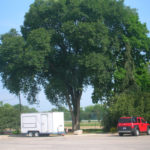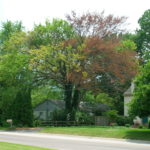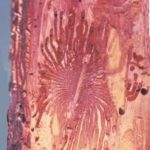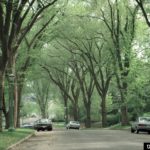 Although most cities contain an Elm Street, very few cities can claim having mature American elms on that street, or any other. The American elm was a premier street tree: Tolerant of compacted soil, fast growing, long-lived, and with a beautiful vase-shaped form. It’s very popularity led to its downfall. The introduction of Dutch elm disease (DED) in the 1900’s began devastating the elm population, which fell like dominos due to its overabundance in the urban and forest landscape. Although no number will be determined, the loss of hundreds of millions of elms is considered a conservative estimate, at best.
Although most cities contain an Elm Street, very few cities can claim having mature American elms on that street, or any other. The American elm was a premier street tree: Tolerant of compacted soil, fast growing, long-lived, and with a beautiful vase-shaped form. It’s very popularity led to its downfall. The introduction of Dutch elm disease (DED) in the 1900’s began devastating the elm population, which fell like dominos due to its overabundance in the urban and forest landscape. Although no number will be determined, the loss of hundreds of millions of elms is considered a conservative estimate, at best.
The elm host. Native Elm species vary in their susceptibility to DED. American elm (Ulmus americana L.) is highly susceptible, cedar elm (U. crassifolia Nutt.), rock elm (U. thomasii Sarg.), September elm (U. serotina Sarg.), slippery elm (U. rubra Muhl.), and winged elm (U. alata Michx.), range from susceptible to somewhat resistant. Although immunity does not appear to exist in native elm populations, select individuals or cultivars have been identified and propagated. European and Asian elms are less susceptible than American elm.
Symptoms. The first symptoms of Dutch elm disease are often overlooked due to the position of wilting leaves on branches in the upper canopy of the tree. Affected leaves usually turn yellow, then brown, and fall prematurely, although some leaves may remain attached. Upon losing its leaves, a branch quickly dies. Trees infected late in the summer or early fall usually survive only to rapidly succumb to the infection the following year. The rate of the infection varies, but an entire tree can die within a few weeks.
- Very early symptoms of Dutch Elm Disease
- Dutch Elm Disease
- Brown streaks in the outer sapwood
DED-infected trees can be readily identified by brown streaks in the outer sapwood after the bark is removed. Keep in mind that elms produce both spring and summer wood, and that as the season progresses, previous vascular staining may be overlaid by unstained wood. It is important to note that elm suffer from other disease, insect and abiotic disorders; Conclusive diagnosis of DED requires laboratory testing.
Causal Agent
Two fungi are responsible for this disease: Ophiostoma ulmi and Ophiostoma novo-ulmi. O. novo-ulmi is often referred to as a “newer, more virulent” version of the originally introduced pathogens. Both pathogens are established in the United States. Both species of Ophiostoma grow in the xylem (water-conducting tissue) of elms. Characteristic wilting results when the plant produces tyloses, gums and resins that block the spread of the fungus. These tyloses expand into the plants xylem, blocking water flow, and resulting in wilting. The fungus then spreads in the xylem, by growing yeast-like and also causing blockage of the xylem vessels. Ophiostoma produces a stalked spore structure within the beetle galleries (called a coremium), which is an aggregate of conidiophores forming a sticky head with millions of asexual spores (conidia). These sticky spores are vectored by the beetle when it moves within the gallery and emerges from April through June, and is the primary means the pathogen spreads from infected to healthy trees either. Beetles exit the trees to feed on small branch crotches of other elms, providing an infection court for the fungus. Mature, adult females lay eggs in the wood of healthy, infected and dying elms. Larvae hatch and feed, forming tunnels from the main brood gallery into the surrounding tissue.
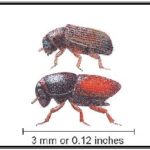 Vector. Two species of beetles vector the pathogen: The European elm bark beetle (Scolytus multistriatus) (Fig. below) is the primary vector, and the native elm bark beetle (Hylurgopinus rufipes), to a lesser extent, spread the fungus from infected to healthy elms. The more common European elm bark beetles overwinter as larvae in recently killed elm wood. Overwintering adults of the native elm bark beetle emerge in the spring and tunnel into the inner bark of branches two to four inches in diameter to feed prior to breeding, when branches are abandoned to lay their eggs. Native bark beetle produce galleries that are bored perpendicularly to the grain of the wood, with developing larvae feeding in the direction of wood grain. In northern areas (Minnesota, Wisconsin, New England, and most of Canada), the native elm bark beetle is the predominant vector.
Vector. Two species of beetles vector the pathogen: The European elm bark beetle (Scolytus multistriatus) (Fig. below) is the primary vector, and the native elm bark beetle (Hylurgopinus rufipes), to a lesser extent, spread the fungus from infected to healthy elms. The more common European elm bark beetles overwinter as larvae in recently killed elm wood. Overwintering adults of the native elm bark beetle emerge in the spring and tunnel into the inner bark of branches two to four inches in diameter to feed prior to breeding, when branches are abandoned to lay their eggs. Native bark beetle produce galleries that are bored perpendicularly to the grain of the wood, with developing larvae feeding in the direction of wood grain. In northern areas (Minnesota, Wisconsin, New England, and most of Canada), the native elm bark beetle is the predominant vector.
Root Graft Transmission. The pathogen also spreads via root grafts formed between adjacent or nearby elm trees (up to 50 feet away) when the root systems of adjacent elms fuse or graft. Should one tree become infected with Ophiostoma, the fungus can readily transmitted to the vascular system of any other via the root- grafted tree. It has been estimated that more than 90 percent of urban elms killed in DED epidemics became infected through root grafts coupled with elm monocultures.
Management
Sanitation. The simplicity of the concept of sanitation belies the great difficulty of its implementation. In order to be successful, DED sanitation programs must be applied without prejudice to the entire community. This includes every urban tree, whether situated in a park, cemetery, vacant lot, or hedgerow. DED-killed trees must be removed, stumps must be ground, and the wood must be promptly destroyed. Any and all wood from an infected tree should be burned, buried, or chipped. Wood chips from DED-infected trees pose no risk of disease transmission. DED-infected elms that are saved for firewood must be debarked, as logs with attached bark provide breeding sites for beetles.
Root Graft Disruption. Before disrupting root grafts, be sure to identify the location of possible buried utilities prior to digging. Disruption of root grafts between infected and healthy elms prevents transmission, thereby disrupting the spread of the disease. Determine the line of root graft disruption between adjacent trees by marking a line equidistant between the infected and adjacent tree. This line indicates where trenching or soil fumigation placed should be done. Trenching can performed with a trencher, ditch witch, vibratory plow, or a sharp spade, and should be dug to a depth of at least four feet.
In much of the urban landscape, trenching is not an option due to power lines, or concrete barriers. In this instance, chemical fumigants (soil sterilants) can be used to disrupt root grafts. One-inch diameter holes should be dug to a depth of two feet deep and placed every six to twelve inches between the two trees at a predetermined site equidistant to both trees. When concrete serves as a barrier, holes should be angled underneath the concrete to effectively distribute the fumigant. As always, follow label directions.
Pruning. Fresh pruning wounds attract beetles that may potentially vector the fungus that causes DED. Because of this, avoid unnecessary pruning whenever the beetles are active (early spring through late fall). If pruning is necessary, be sure to apply wound paint to prevent beetle/fungus access to wounds. This is one of the only instances when wound paint is warranted.
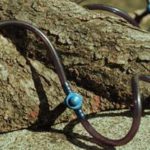 Fungicide injection. Although fungicide injections have been successfully used for decades to protect and treat trees against DED, this option has not garnered wide-spread acceptance. First off, fungicide injections are more successful in preventing infection than treating already infected trees. Therapeutic treatment with either Arbortect, or Alamo is rarely successful when more than 25% of the canopy is symptomatic.
Fungicide injection. Although fungicide injections have been successfully used for decades to protect and treat trees against DED, this option has not garnered wide-spread acceptance. First off, fungicide injections are more successful in preventing infection than treating already infected trees. Therapeutic treatment with either Arbortect, or Alamo is rarely successful when more than 25% of the canopy is symptomatic.
Fungicides are injected into the vascular system of elms in one of three ways: Microinjection forces a reduced volume of fungicide into holes drilled into the stem or base of the tree. Macroinjection is forceful injection of large volumes of a diluted fungicide or via infusion (without pressure) of large volumes of dilute chemical solutions into holes drilled in the stem or base of the tree An third injection technique uses plastic capsules containing concentrated fungicide. Capsules are tapped into holes in the root flare.
To date, at least six chemicals are registered in the USA for injection to manage DED, and although it is legal for homeowners to apply injection treatments to their own trees, success rates are not as high.
Adjuvants as Chemical Carriers. The recent introduction, and subsequent labeling of Pentra-bark (Polyalkylene Modified Heptamethyltrisiloxane and nonionic surfactants) is changing how arborists can treat trees. Pentra-bark is an adjuvant that allows the transport of chemicals from the bark to the cambium of trees. To date, there are no data that demonstrates efficacy of this approach to manage Dutch elm disease.
DED-Resistant Elms
Fungicides and sanitation have had limited success in the management of DED. Any long- term redeployment of elms in North America requires the identification and breeding of resistant elms. The use of European and Asian elms to introgress resistance, and the identification and propagation of DED-tolerant or resistant American has resulted in the identification of several cultivars showing high levels of DED tolerance and/or resistance.
In the decades since DED was introduced, American elms have been identified, and hybrid elms have been bred to be resistant to the disease, and these plants are now readily available to the public. It is important to note that resistance is not immunity, and resistance is impacted by climatic conditions (such as drought), bark beetle population, and surrounding sanitation, site, and overall tree health.
Link to American Elm Clones of Importance in Dutch Elm Disease Tolerance Study (12haugen-bentz-gtr-p-174) by Linda M. Haugen and Susan E. Bentz
Managing DED- resistance as a genetic resource requires careful deployment of these varieties. Resistance is not the same as immunity, and stressed or poorly maintained trees will get infected. To minimize the likelihood of this, trees should be used more as specimens to diversify a landscape, as opposed to the monocultures that were once planted. Although these elm monocultures are visually pleasing, overuse of any cultivar or species should be avoided, to increase overall biodiversity and long-term ecosystem stability.
References:
Dunn, C.P. 2000. The Elms: Breeding, Conservation, and Disease Management. Kluwer Academic Publishers.
Stennes, M. and Haugen, L. 1999. Fungicide injections to control Dutch elm disease. Plant
Diagnosticions Quarterly (PDQ) 20 (2):29-38
Sinclair, W. and Lyon, H. 2005. Diseases of Trees and Shrubs
